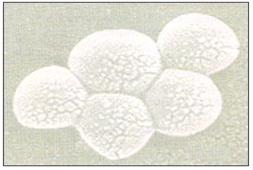신생아의 면역체계, Immune system in newborn infants
- 갓 태어난 신생아들은 물론이고 그 후 신생아들은 바이러스 감염이나 박테리아 감염에 저항할 수 있는 면역체를 모체로부터 어느 정도 얻어 가지고 출생한다.
- 태어나기 전 모체로부터 얻은 면역체는 출생 이후 점차로 줄어들기 시작해서 생후 9개월경에는 거의 다 없어지고 태어나자마자 곧 신생아 자신이 면역체를 만들기 시작해서 자신들이 만든 면역체로 모체에서 받은 면역체는 전부 대치된다.
- 태어나기 전 모체에서 얻은 면역체를 신생아들이 가지고 있다고 해서 신생아들에게 감염되는 모든 병원체를 막아낼 수 있는 모든 종류의 면역체가 있는 것은 아니다.
- 신생아들의 면역 기능 체계가 전반적으로 미숙해서 여러 종류의 병원체의 침입을 더 쉽게 받을 수 있고 감염병에 더 잘 걸릴 수 있다.
- 또 일반 병원체에 감염되어 생긴 감염병을 더 심하게 앓을 수 있다. 그러므로 감염병에 걸리지 않게 특별히 조심해야 한다.
- 태어난 날부터 신생아는 스스로 면역체를 직접 만들기 시작해서 생후 9∼12개월경에는 신생아가 가지고 있는 면역체의 거의가 아기 자신이 만들은 면역체이다.

사진2-218.황색 포도상구균
메티실린에 내성이 있는 황색 포도상구균과 메티실린 내성이 없는 황색 포도상구균으로 분류된다. 신생아는 이 세균에 감염되기 쉽다.
출처; CDC와 Infectious Diseases In Children December 2012
Immune system in newborn infants 신생아의 면역체계
- Newborns and infants after that are born with a certain amount of immunity from the mother that can resist viral or bacterial infections.
- The immunity obtained from the mother before birth begins to gradually decrease after birth, and almost disappears around 9 months of age.
- As soon as the newborn is born, the immunity itself starts to be made, and all the immunity received from the mother is replaced with the immunity they have created.
- Just because newborns have immunity from their mother before birth does not mean that they have all kinds of immunity that can block all pathogens that infect them.
- Newborns’ immune systems are generally immature, making them more susceptible to invasion of many types of pathogens and more susceptible to infectious diseases.
- In addition, they can suffer more severely from infectious diseases caused by infection with common pathogens. Therefore, you must be particularly careful not to get infectious diseases.
- From the day of birth, newborns start to make their own immune bodies, and by the age of 9-12 months, most of the newborn’s immune bodies are made by the baby himself.

Photo 2-218. Staphylococcus aureus. It is classified into Staphylococcus aureus, which is resistant to methicillin and Staphylococcus aureus, which is not resistant to methicillin.
Newborns are susceptible to this germ. source; CDC and Infectious Diseases In Children December 2012
출처 및 참조 문헌
- NelsonTextbook of Pediatrics 22ND Ed
- The Harriet Lane Handbook 22ND Ed
- Growth and development of the children
- Red Book 32nd Ed 2021-2024
- Neonatal Resuscitation, American Academy Pediatrics
- www.drleepediatrics.com 제1권 소아청소년 응급 의료
- www.drleepediatrics.com 제2권 소아청소년 예방
- www.drleepediatrics.com 제3권 소아청소년 성장 발육 육아
- www.drleepediatrics.com 제4권 모유,모유수유, 이유
- www.drleepediatrics.com 제5권 인공영양, 우유, 이유식, 비타민, 미네랄, 단백질, 탄수화물, 지방
- www.drleepediatrics.com 제6권 신생아 성장 발육 육아 질병
- www.drleepediatrics.com제7권 소아청소년 감염병
- www.drleepediatrics.com제8권 소아청소년 호흡기 질환
- www.drleepediatrics.com제9권 소아청소년 소화기 질환
- www.drleepediatrics.com제10권. 소아청소년 신장 비뇨 생식기 질환
- www.drleepediatrics.com제11권. 소아청소년 심장 혈관계 질환
- www.drleepediatrics.com제12권. 소아청소년 신경 정신 질환, 행동 수면 문제
- www.drleepediatrics.com제13권. 소아청소년 혈액, 림프, 종양 질환
- www.drleepediatrics.com제14권. 소아청소년 내분비, 유전, 염색체, 대사, 희귀병
- www.drleepediatrics.com제15권. 소아청소년 알레르기, 자가 면역질환
- www.drleepediatrics.com제16권. 소아청소년 정형외과 질환
- www.drleepediatrics.com제17권. 소아청소년 피부 질환
- www.drleepediatrics.com제18권. 소아청소년 이비인후(귀 코 인두 후두) 질환
- www.drleepediatrics.com제19권. 소아청소년 안과 (눈)질환
- www.drleepediatrics.com 제20권 소아청소년 이 (치아)질환
- www.drleepediatrics.com 제21권 소아청소년 가정 학교 간호
- www.drleepediatrics.com 제22권 아들 딸 이렇게 사랑해 키우세요
- www.drleepediatrics.com 제23권 사춘기 아이들의 성장 발육 질병
- www.drleepediatrics.com 제24권 소아청소년 성교육
- www.drleepediatrics.com 제25권 임신, 분만, 출산, 신생아 돌보기
- Red book 29th-31st edition 2021
- Nelson Text Book of Pediatrics 19th- 21st Edition
- The Johns Hopkins Hospital, The Harriet Lane Handbook, 22nd edition
- 응급환자관리 정담미디어
- Pediatric Nutritional Handbook American Academy of Pediatrics
- 소아가정간호백과–부모도 반의사가 되어야 한다, 이상원 저
- The pregnancy Bible. By Joan stone, MD. Keith Eddleman, MD
- Neonatology Jeffrey J. Pomerance, C. Joan Richardson
- Preparation for Birth. Beverly Savage and Dianna Smith
- 임신에서 신생아 돌보기까지. 이상원
- Breastfeeding. by Ruth Lawrence and Robert Lawrence
- Sources and references on Growth, Development, Cares, and Diseases of Newborn Infants
- Emergency Medical Service for Children, By Ross Lab. May 1989. p.10
- Emergency care, Harvey Grant and Robert Murray
- Emergency Care Transportation of Sick and Injured American Academy of Orthopaedic Surgeons
- Emergency Pediatrics A Guide to Ambulatory Care, Roger M. Barkin, Peter Rosen
- Quick Reference To Pediatric Emergencies, Delmer J. Pascoe, M.D., Moses Grossman, M.D. with 26 contributors
- Neonatal resuscitation Ameican academy of pediatrics
- Pediatric Nutritional Handbook American Academy of Pediatrics
- Pediatric Resuscitation Pediatric Clinics of North America, Stephen M. Schexnayder, M.D.
-
Pediatric Critical Care, Pediatric Clinics of North America, James P. Orlowski, M.D.
-
Preparation for Birth. Beverly Savage and Dianna Smith
-
Infectious disease of children, Saul Krugman, Samuel L Katz, Ann A.
- 제4권 모유, 모유수유, 이유 참조문헌 및 출처
- 제5권 인공영양, 우유, 이유, 비타민, 단백질, 지방 탄수 화물 참조문헌 및 출처
- 제6권 신생아 성장발육 양호 질병 참조문헌 및 출처
- 소아과학 대한교과서
-
Copyright ⓒ 2015 John Sangwon Lee, MD., FAAP
미국 소아과 전문의, 한국 소아청소년과 전문의 이상원 저 “부모도 반의사가 되어야 한다”-내용은 여러분들의 의사로부터 얻은 정보와 진료를 대신할 수 없습니다.
The information contained in this publication should not be used as a substitute for the medical care and advice of your doctor. There may be variations in treatment that your doctor may recommend based on individual facts and circumstances. “Parental education is the best medicine.”